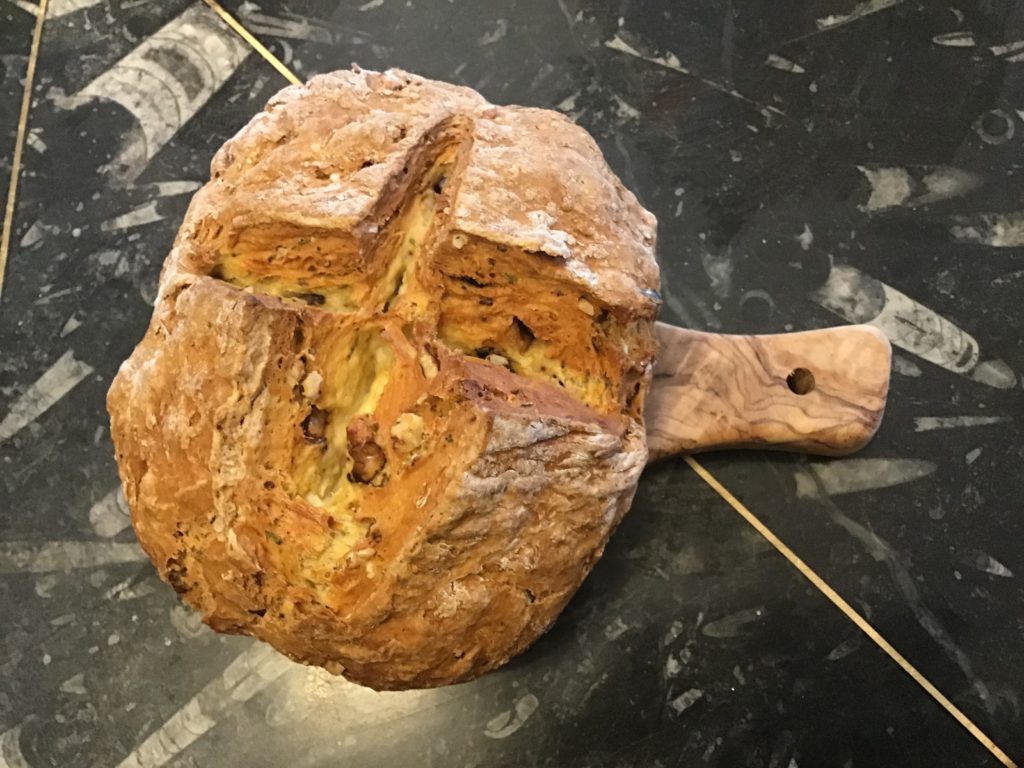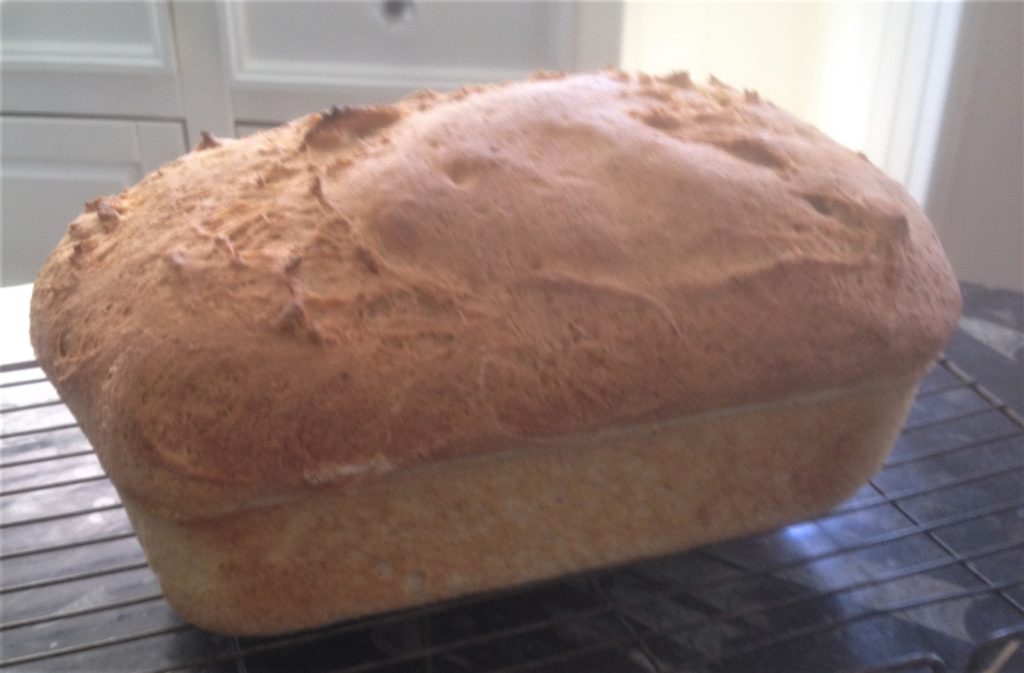When the boys were teenagers, I began making bread – badly. Fortunately, no-one seemed to mind, because it went a little way towards appeasing their endless appetites. I persevered and gradually became competent. Time passed – they left home, I got sick, and breadmaking was abandoned. Then came lock-down and those rusty bread making skills, like dried yeast, were reactivated.
We couldn’t buy bread, so once again I started making my own. I had much to relearn, but gradually I got there. When bread was once again available in the shops, I wasn’t interested. Homemade bread is so superior in every way (even an imperfect loaf) that I’ve figured it in to my weekly to-do list.
The process of making bread is simple, but learning how to judge if it is right at each stage is not. If you don’t have an experienced bread maker at hand to show you, there may be a bit trial and error here. But the challenge is part of the fun. And what do you have to lose? The making part only takes perhaps half and hour, the ingredients cost pennies and if the result is even half-way good, your family will love you! Few things elicit the warm fuzzy feelings of a loaf hot from the oven. So have a go. If I can do it, anyone can.
Amazing adventures in breadmaking
During lock-down, sourcing ingredients was hard, so we all had to get a bit imaginative. Some of the braver sort ventured into sourdough and the less ambitious, like me, tried beer as a raising agent. Finding a lone bottle of Corona (ah, the irony) left over from a distant party and using my son’s sweet girlfriend’s recipe, I had a go at beer bread. Suffice to say, beer is an excellent yeast substitute.

Unable to get spelt flour, I tried Einkorn. It is a tasty grain and makes a beautiful loaf, but unlike almost all breads is allergic to kneading. I even had a go with gluten free flour, though unless you are celiac, it is not something I would recommend!
Quick breads
A good place to start if you are feeling a little nervous about bread making is with quick breads. These take literally minutes to prepare and not much longer to bake. They do not require yeast and instead use some variation on baking powder as a raising agent. My husband is now pretty adept at flat breads and I love making them too, as well as corn and soda bread. Like all breads, they freeze well, so make a big batch and freeze any left-over.

A word about flour
Flour, like everything, has a sell-by date. For the best baking, make sure that your flour is as fresh as possible (also the yeast). We all have things at the back of the cupboard that we are sure we’ll use some day, but if it is out of date, throw it away and save yourself the bother of an unsuccessful bake.
As we grow older, our ability to digest is often compromised. MS unfortunately exacerbates this too, so I use spelt as an alternative to wheat flour and if you are finding wheat a little heavy (and have no allergies), this can be a perfect alternative. Whenever possible, try to add fibre. Adding a cup of rye or half white and half brown flour will result in a lovely light loaf. Of course, fully whole grain is nutritionally the best. And be adventurous! The range of flours available is staggering. Just remember to consult the packet for any quirks they have when it comes to bread making.

Getting started
For those of you who are not already in the bread making groove, here’s a simple recipe to get you started. It makes two small loaves or 12 dinner rolls.
Ingredients
5 cups (600g) of flour. (I use 4 cups of spelt and 1 of rye)
1 heaped teaspoon of dried active yeast
1 teaspoon sugar
1 teaspoon salt
400 ml of warm water (200 ml of boiling and 200 ml cold)
Oil for greasing (I use olive oil)
Method
In a warm bowl, mix all the dry ingredients. (I use a mixer with a dough hook, but you can easily do all this bit by hand.) Very slowly add the water with the mixer on 1. Knead for about 5 minutes. You have the right amount of water when the dough comes away cleanly from the bowl. Don’t worry if you add a bit too much, you can add flour when you knead it in the next part.
Place the dough on a well-floured surface and knead for a further five minutes by hand. When it feels smooth and springy to the touch and has the texture of your earlobe, it is ready for its rise. Pour a tablespoon of oil into a bowl, add the dough and swirl to coat. Cover with a tea towel and leave to rise in a warm place for about 45 minutes. (A sunny window ledge is ideal or a draught-free room. Draughts are the enemy of all things dough.)
When the dough has doubled in size, give it a good punch to remove all the gases created by the yeast. (What we call yeast farts in my uncouth family!) This will ensure your bread has no bitter aftertaste.
Return to the well-floured surface and knead again for 5-10 minutes. Kneading is a great tool for anger management.
Grease the tins you are using very generously with oil using a pastry brush. Muffin tins make great flower pot rolls; sandwich tins even round ones; loaf tins makes bread perfect for slicing and baking trays for the rustic dome.
Add the dough, cover and leave again in a warm place to double in size.
Think about heating your oven at this point. It needs to be really hot when you add the dough. Mine takes about 15 minutes.
When the dough is lovely and plump and the oven hot, it’s time to bake the bread. If you like a crusty top, add a deep baking tin about 1/3 full of water and place in the bottom of the oven. (Take care of steam when opening oven.) Bake rolls for 20 minutes and larger loaves for 30 minutes at 220C. They are ready when the tops are golden and bottom sounds hollow when tapped.
Tip out the bread on a cooling rack and when room temperature, enjoy! Only keep out what you are going to use that day. Bread freezes brilliantly, so pop the rest away for when you will use it.

Just the beginning
Once you get started on your bread journey, you will find that it becomes addictive. There are so many options for bread making and all of them delicious. It is very easy to add seeds and dried fruits, herbs and spices. (I do this after the first rise.) Breads can be sweet or savoury, plain rounds or elaborate designs. If you want inspiration, I’d recommend The Great British Bake Off where the contestants take simple bread making to dizzying heights. Paul Hollywood won’t be giving me prizes any time soon, but I’m enjoying the learning process. I’m feeling the urge to make focaccia, and bagels and crisp bread and … well, the list is almost endless.
